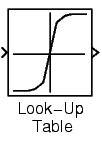

| Simulink Reference |   |
Approximate a one-dimensional function using the specified lookup method
Library
Simulink Look-Up Tables and Fixed-Point Blockset LookUp
Description
The Look-Up Table block computes an approximation to some function y=f(x) given data vectors x and y.
| Note To map two inputs to an output, use the Look-Up Table (2-D) block. |
The length of the x and y data vectors provided to this block must match. Also, the x data vector must be strictly monotonically increasing after conversion to the input's fixed-point data type, except in the following case. If the input x and the output signal are both either single or double, and if the lookup method is Interpolation-Extrapolation, then x may be monotonically increasing rather than strictly monotonically increasing. Note that due to quantization, the x data vector may be strictly monotonic in doubles format, but not so after conversion to a fixed-point data type.
You define the table by specifying the Vector of input values parameter as a 1-by-n vector and the Vector of output values parameter as a 1-by-n vector. The block generates output based on the input values using one of these methods selected from the Look-up method parameter list:
Interpolation-Extrapolation--This is the default method; it performs linear interpolation and extrapolation of the inputs.
Interpolation-Use End Values--This method performs linear interpolation as described above but does not extrapolate outside the end points of the input vector. Instead, the end-point values are used.
Use Input Nearest--This method does not interpolate or extrapolate. Instead, the element in x nearest the current input is found. The corresponding element in y is then used as the output.
Use Input Below--This method does not interpolate or extrapolate. Instead, the element in x nearest and below the current input is found. The corresponding element in y is then used as the output. If there is no element in x below the current input, then the nearest element is found.
Use Input Above--This method does not interpolate or extrapolate. Instead, the element in x nearest and above the current input is found. The corresponding element in y is then used as the output. If there is no element in x above the current input, then the nearest element is found.
To create a table with step transitions, repeat an input value with different output values. For example, these input and output parameter values create the input/output relationship described by the plot that follows:
This example has three step discontinuities: at u = -1, 0, and +1.
When there are two points at a given input value, the block generates output according to these rules:
The Look-Up Table block icon displays a graph of the input vector versus the output vector. When a parameter is changed on the block's dialog box, the graph is automatically redrawn when you click the Apply or Close button.
When the Show additional parameters check box is selected, some of the parameters that become visible are common to many blocks. For a detailed description of these parameters, refer to Block Parameters in the Fixed-Point Blockset documentation.
To avoid parameter saturation errors, the automatic scaling script autofixexp employs a special rule for the Look-Up Table block. autofixexp modifies the scaling by using the output look-up values in addition to the logged minimum and maximum simulation values. This prevents the data from being saturated to different values. The look-up values are given by the Vector of output values parameter (the YDataPoints variable).
Parameters and Dialog Box
single or double, and if the lookup method is Interpolation-Extrapolation, then the input values vector may be monotonically increasing rather than strictly monotonically increasing. Note that due to quantization, the input values vector may be strictly monotonic in doubles format, but not so after conversion to a fixed-point data type. Specify via dialog, the Output data type, Output scaling value, and Lock output scaling against changes by the autoscaling tool parameters become visible.Specify via dialog is selected for the Output data type mode parameter.Specify via dialog is selected for the Output data type mode parameter.Specify via dialog is selected for the Output data type mode parameter.Conversions and Operations
The Vector of input values parameter is converted from doubles to the input data type. The Vector of output values parameter is converted from doubles to the output data type. Both conversion are performed offline using round-to-nearest and saturation. Refer to Parameter Conversions in the Fixed-Point Blockset documentation for more information about parameter conversions.
Examples
Suppose the Look-Up Table block in the above model is configured to use a vector of input values given by [-5:5], and a vector of output values given by sinh([-5:5]). The following results are generated.
Characteristics
| Dimensionalized |
Yes |
| Direct Feedthrough |
Yes |
| Sample Time |
Inherited from driving block |
| Scalar Expansion |
No |
| Zero Crossing |
No |
See Also
Look-Up Table (2-D), Look-Up Table (n-D)
 | Logical Operator | Look-Up Table (2-D) |  |